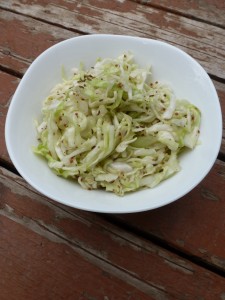 Recently I was shocked to discover that many people have bad childhood memories of “creamy” coleslaw. I was raised on chopped cabbage in mayonnaise, a creamy slaw that we called cabbage salad. Many detest this side dish so much that they have given up slaw all together.
Recently I was shocked to discover that many people have bad childhood memories of “creamy” coleslaw. I was raised on chopped cabbage in mayonnaise, a creamy slaw that we called cabbage salad. Many detest this side dish so much that they have given up slaw all together.
I’d like to vouch for a different style of coleslaw, one that has more in common with the German Krautsalat than the classic mayo-bound North American slaw.
The main difference is that it’s dressed in a vinaigrette, instead of mayonnaise or buttermilk. But before we discuss dressing, there’s a very important technique to consider.
Lightly Curing Cabbage for Slaw
There are very few vegetables that I truly enjoy raw. Good carrots, radishes, and snap peas are the only ones that come to mind right now. I think every other vegetable is better once it has been roasted or blanched or pickled or at the very least lightly cured, as described here.
Once I have sliced my cabbage into thin strips 2 to 3″ long, I toss those strips with 1% of their weight in salt, and 1% of their weight in sugar. In other words, for each kilo of sliced cabbage, add 10 g each of salt and sugar. Mix thoroughly and let the cabbage stand at room temperature for about an hour. The transformation that takes place is subtle, but important.
Raw sliced cabbage is a bit stiff: it tends to stand up, and sometimes it reminds me of straw in my mouth.
During this light curing process, the cabbage starts to leach a bit of liquid. Not so much that it becomes desiccated; just enough to get the juices flowing. It takes on a faint luster, a brighter green hue, and the ribbons of cabbage become ever-so-slightly limp. And of course the cabbage takes on salt and sugar, enhancing the natural flavour of the vegetable. The strips still have the crunch and mustardy bite of raw cabbage, but they are far more appetizing.
For Krautsalat the Germans and Austrians take this process a bit further, letting the cabbage sit for several hours, then aggressively pressing it to remove excess moisture.
The Dressing
Mustard and cabbage are friends. They’re both brassicas, and they share a lot of the same flavour characteristics. Apples and cabbage are also friends, though the reasons for this are much more mysterious to me. The two main flavours of my slaw dressing are therefore mustard and apple cider vinegar. I sweeten it with honey, and whisk it with canola oil. If you want to add another level of flavour, try adding caraway, celery seed, and mustard seed. My preferred slaw dressing is detailed in this post on vinaigrettes.
Uses
Slaw is an essential component of any barbecue, especially true barbecue like pulled pork. It’s also a good accompaniment to ham, or fried meat, like schnitzel. And it’s useful as a dish for picnics.
Allan’s Default Slaw
Ingredients
- 1 kg raw cabbage, cored and sliced into thin strips about 2″ long
- 10 g kosher salt
- 10 g granulated sugar
- 1 cup of the honey mustard dressing described in this post
Procedure
- Toss the cabbage, salt, and sugar in a large bowl and let stand until the cabbage has released some moisture and become slightly limp, 1 to 2 hours.
- Lightly press the cabbage and strain out the liquid that has settled at the bottom of the bowl.
- Toss the lightly cured cabbage with the dressing.
General Slaw Method
The procedure above can be used to make a number of different slaws and salads. Carrot, for instance, or cucumber. Lightly cure carrots in the manner described above, then dress them in tangy yogurt and mint leaves.